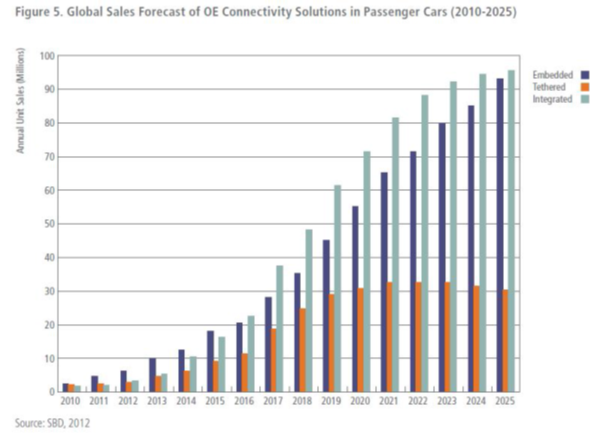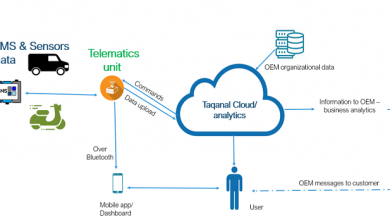Connected cars advancing the need for automotive applications
The Facts
- 660,000 drivers in the U.S. are using cellphones or other devices at any given moment during daylight hours. In 2012, more than 3,328 people were killed on the road, and 421,000 were injured in crashes involving a distracted driver.
- NHTSA (National Highway Traffic Safety Assn.)
- At any given daylight moment across America, approximately 660,000 drivers are using cell phones or manipulating electronic devices while driving, a number that has held steady since 2010. (NOPUS)
- Engaging in visual-manual subtasks (such as reaching for a phone, dialing and texting) associated with the use of hand-held phones and other portable devices increased the risk of getting into a crash by three times. (VTTI)
The majority of cars sold today are Internet-enabled and car manufacturers are rolling out an increasing number of connected in-car services. The in-car connectivity today is enabled using embedded SIMs or tethered mobiles devices, each approach with its own advantages and disadvantages and its own trends. With the recent announcements by Google and Apple, in-car apps powered by mobile phones and mirrored to headunits seem to be a growing trend.
Parkopedia is adamant to see more tightly integrated services which reduce distraction and provide a better user experience. Instead of drivers having to use one app for nav, one for traffic and one for parking or fuel, a single service provider with all in-car services integrated into consistent and user friendly service is far more valuable.
The fragmentation of user attention across multiple apps provides less than ideal UX. Users shouldn’t need to switch from one app to another to get the information that they need. Services including nav/traffic/fuel/parking should be tightly integrated and enhanced with additional functionality such as safe texting/calling and music capabilities.
The most significant factors for apps/content is that it must be simple and relevant. Over the next 5 years, we will no doubt see a change in the dynamics in the automotive apps market. There is a potential for Google and Apple to take over the headunit and driver’s attention. “Standard” automotive way of doing business and integrating content (i.e. slow and expensive) might be entirely disrupted by mobile driven integrations.
Parkopedia as contributor to the growth of cloud interactivity and connected car
Parkopedia provides automotive OEMs and Tier-1 suppliers with parking services which allow drivers to find and pay for parking in 6000 cities and 45 countries. Parkopedia services are available either as an in-car application (iOS/Android/HTML5) or as a standalone service which can be whitelabeled and integrated directly into the navigation system. One of Parkopedia’s most sophisticated integrations to date is Volvo’s “Park & Pay” application.
Parkopedia worked closely with Volvo to develop the world-first in-car parking service that allows drivers to pay for parking from the convenience of their car. It also provided Volvo directly with all of the APIs powering parking search and payments and worked closely with Volvo on designing the app UX.
Parkopedia’s work with Ford is another innovative app based project. The company recently launched a voice-activated parking discovery app for Ford SYNC AppLink – North American first. Using the AppLink interface, Ford drivers around the world are now able to locate available nearby parking and get detailed information through simple voice commands, eliminating the need to touch their mobile phone while driving.
The Future
The Connected Vehicle is here to stay!
..and parking has a crucial role to play in this technical evolution.
Areas of particular importance to the parking industry include:
Provide/Integrate inexpensive, but accurate real time space availability: Unlike existing sensor-based solutions, the technology being developed provides similar space availability finding benefits; without any infrastructure investment.*
Improving/Integrating parking space forecast predictions: Future use of additional sources like real-time traffic and weather to improve space forecast predictions. Drivers anywhere in the world will always be able to see the chances are of finding a street parking space based on the day and time of their arrival even in a location which has no barriers or sensors installed thus reducing congestion, noise pollution and CO2 emissions.
Making parking greener: Enabling drivers to make ‘intelligent’ parking decisions and drive to where there is an on-street space available. The car/mobile app will give various options to the driver (i.e. drive to the closest parking lot or a nearby one if the closest is going to be full). Drivers using mobile apps are then immediately directed to their chosen parking space; without the need to drive around looking for a space; thus reducing congestion, noise pollution and C02 emissions.
Working closely with cities and municipalities: Parkopedia has been working closely with municipalities to develop innovative technology that uses various sources of information such as historical payment transactions and mobile user feedback to provide forecasts of parking space availability in the future. This information is then relayed in real-time to drivers using mobile and car navigation systems.
Author:
Eugene Tsyrklevich, CEO, Parkopedia
10620 Treena Street #230
San Diego, CA92129
+ 1 (917) 310-3178, eugene@parkopedia.com





